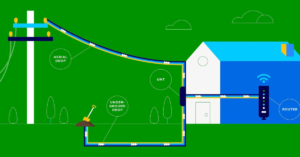Introduction
The significance of having communication systems that are both reliable and effective cannot be emphasized in the context of our quickly developing digital global environment. Fiber optic technology is leading this technological revolution with its unmatched reliability and data transfer rates. This guide offers an introductory tour for those who want to learn more about and get involved in the dynamic field of fiber optic network installation.

Fibre optic networks are:
- The foundation of the world’s telecommunications infrastructure.
- Providing support for various technologies, including high-speed internet and cable television.
- Advanced networking in data centers.
The transition from conventional copper wires to fiber optics is a major technological advancement that addresses the increasing need for bandwidth and quicker data transfer speeds.
The goal of this tutorial is to provide some clarity on the fiber optic network construction process. The fundamentals of fiber optic technology, network planning and design, installation, testing and debugging, and continuous maintenance and upgrades will all be covered. Regardless of your background—student, aspiring telecom professional, or simply interested in technology—this guide will provide you with a strong foundation in fiber optic network building.
Understanding Fiber Optics
Before building a fiber optic network, one must comprehend fiber optics and the reasons behind their revolutionary advancements in data transfer. Thin glass or plastic strands called optical fibers, which carry data in the form of light, make up fiber optic cables. Fiber optics have data using light pulses rather than electrical impulses, which results in far faster speeds and less signal loss than conventional metal cables.
An optical fiber’s cladding, or outside layer, reflects light into the fiber’s core to minimize signal loss during transmission. Afterward, a coating is applied to the entire fiber to protect it from the elements and physical harm.
Single-mode and multi-mode fiber optic cables are the two main varieties. Due to their small core diameter, single-mode fibers are utilized for long-distance transmission with little signal loss. Multi-mode fibers, on the other hand, have a bigger core and are usually used for shorter distances, such as those found inside campuses or buildings.
Fiber optic cables have many benefits over conventional copper lines. They have higher bandwidth capacity, are less vulnerable to electromagnetic interference, can transport data over longer distances without experiencing appreciable signal loss, and are more secure against data breaches.
Anyone interested in building a fiber optic network should grasp these principles, as they serve as the foundation for all further design and implementation phases.
Planning Your Fiber Optic Network
Careful planning is the initial stage in building a fiber optic network. Setting the foundation for a successful implementation requires this phase. There are numerous important steps in planning:
Needs Analysis
Start by analyzing your network’s needs. Determining the scope and scale—for a single building, a school, or a citywide network—is part of this. Consider the quantity of users, the kind of data being transferred, and potential scalability.
Designing the Layout: The network’s layout must be created after the needs have been determined. This entails laying out the wires’ actual physical route. Geographical barriers, existing infrastructure, and applicable laws or regulations are all important considerations. This may entail bargaining with other utility companies and city planners in urban areas.
Choosing the Right Fiber
It’s important to make the right choice when it comes to fiber optic cables. Single-mode fibers are commonly utilized for applications requiring high bandwidth across long distances. Multi-mode fibers are better suited for shorter distances with higher data volumes, like those found in data centers. Future upgrade plans and financial restrictions also influence the decision.
Budgeting and Resource Allocation
Building a fiber optic network requires a large financial outlay. Costs for labor, equipment, materials (such as cables and connections), and any unforeseen circumstances should all be factored into your budget. Allocating resources also entails planning the leasing of labor and equipment.
Permits and Legal Requirements
Building permits may be required depending on the site. This is particularly the case when excavating trenches or erecting poles. Adherence to municipal, state, and federal laws is required.
Safety Planning
When building a network, safety must come first. Plans must cover worker safety measures, particularly while working beneath the surface, with large machinery, or at heights.
Construction Basics
After planning is finished, the fiber optic network must be physically built. There are multiple crucial steps in this process:
Trenching and Ducting
Trenches must be dug to install fiber optic cables for underground networks. Environmental factors and regional laws determine these trenches’ width and depth. To protect the wires, ducts constructed of sturdy materials like PVC are placed in these excavations.
Installation of the Cable
In certain situations, fiber optic cables can be run underwater, hung from poles, or installed underground. The network architecture and surrounding conditions determine the installation technique. During installation, extra caution must be used to prevent cable damage.
Splicing and Termination
Splicing fiber optic cables together is linking them. Fusion and mechanical splicing are the two available techniques. Because of its endurance and reduced light loss, fusion splicing—where fibers are welded together using an electric arc—is recommended. Fibre optic cable termination entails attaching the ends of the cables to devices or other wires.
Patch panels and cross-connects
These devices are used to arrange and maintain connections in bigger networks. They make network management easier and more flexible.
Testing and Troubleshooting
Testing is essential to guaranteeing the network’s efficiency and functionality after it is built. The main objectives are finding any errors or losses in the network and confirming that data is being transmitted correctly via fiber optic cables.
Power Meter Testing
A power meter monitors the light power transmitted through the fibers to determine loss at certain locations.
OTDR Testing
An Optical Time-Domain Reflectometer (OTDR) detects the light reflected to the device after passing a series of light pulses through the fiber. This aids in locating flaws or breakage in the cable precisely.
Troubleshooting is the process of locating and fixing problems such as bends, breakage, or malfunctioning connectors. Re-splicing cables or swapping out broken pieces are frequently needed for this.
Maintenance and Upgrades
Maintenance-wise, fiber optic networks are less complicated than conventional copper networks. Nonetheless, to preserve peak performance, routine checks are essential. Potential problems, including cable damage, connector wear, or environmental effects, can be found during inspections.
A fiber optic network can be upgraded by introducing new technologies as they become available, adding more fibers to existing connections (if they are made to be scalable), or replacing hardware such as switches and routers.
Conclusion
launching the fiber optic network’s development. It is a challenging yet worthwhile undertaking. Because fiber optics are so efficient and fast in the communications industry, they constitute an essential component of the contemporary digital infrastructure.
The keys to creating a successful network for newcomers to this sector are knowing the fundamentals of fiber optics, careful planning, systematic construction, and rigorous testing. Though this tutorial offers a basic overview, keep in mind that building fiber optic networks requires precise measurements, extensive technical knowledge, and occasionally, professional experience.
The advancement of fiber optic technologies is still shaping the future of telecommunications. Our need for digital connectivity will only increase, making the expertise and understanding in this field more and more vital. The potential in this profession is wide and exciting for individuals who are prepared to put in the time and effort to learn and engage.
In conclusion, understanding fiber optic network construction opens doors to innovation and technological advancement for students, professionals, and technology enthusiasts. This is a journey where the goal is to connect the world at the speed of light, not only lay cables and connect fibers.

